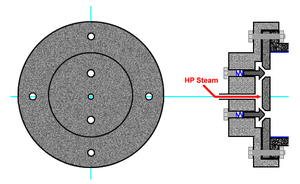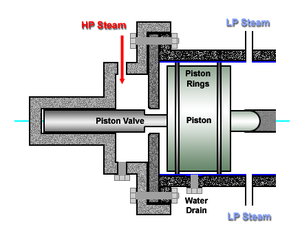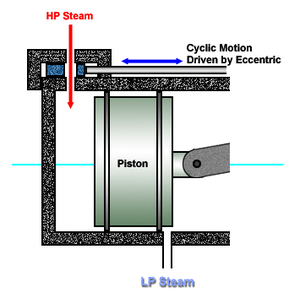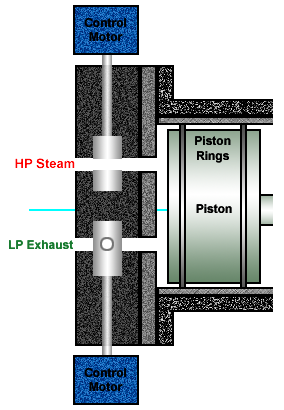Steam Engine Design/Valves
Main > Energy > Steam Engine
General Valve Notes
Various types and kinds of valves used in steam engines are summarized here.
Placement of Exhaust Port Placement of the exhaust port in the cylinder wall vs. the fully extended position of the piston matters as it determine the amount of time that steam has to escape the chamber. If the distance is too short, steam will be compressed on the return stroke and thus reduce the amount of work done by the engine.
Water Build-up If water builds up in the cylinder without some way to relieve it, it can result in a blow-out of the cylinder end caps. Perhaps the water drain plug can be a valve itself, held in place with a strong string. If water builds up in the cylinder, it will eventually force the water drain valve to open and blow out some of the water. Springs will have to hold against the maximum steam pressure, however.
Uniflow Engines "Steam Engine Valves", Pg. 107 describes Uniflow Engines. Steam admission is done with drop valves.
Control Valve Designs
Bump (or Bash) Valve
See Steam Engine Design/Bump Valve
The bump valve is our primary candidate for the first prototype of the OS Steam Engine. Simplicity is in it's favor, but has also been shown to work successfully in other steam engines, particularly the White Cliffs steam engine (see Steam Engine Design/White Cliffs.
Piston Valve
See Steam Engine Design/Piston Valve
The piston valve eliminates the need for a spring to hold the valve against the valve seat when steam is not being let into the cylinder chamber.
Slide Valve
See Steam Engine Design/Slide Valve
A popular valve used in many early and model steam engines.
Solenoid Valve
See Steam Engine Design/Solenoid
Computer controlled solenoid valves allow complete control over steam admission into a cylinder. An earlier version of the Steam Engine Design/2009 was focused on using solenoids as the control mechanism. While OSE may return to that as a control technique, an open source solenoid needs to be designed and developed capable of handling steam pressures (200+ psi).
Rotating Valve
See Steam Engine Design/Rotating Valve.
A rotating ball or cylinder controlled by a stepper motor that allows precise, computer control over when steam is admitted into the piston chamber.
Pressure Relief Valves
Weight Based Pressure Relief
See Steam Engine Design/Pressure Relief Valve.
Flow Control Valves
- Needle valves



